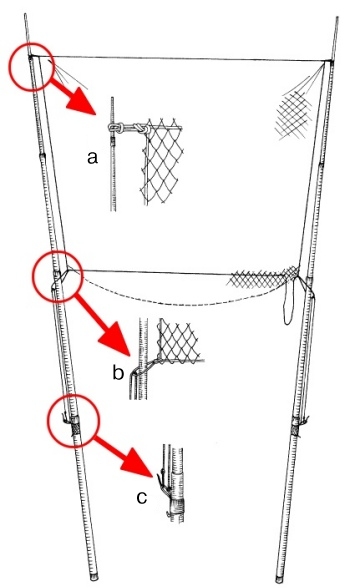|
A mobile trap for capturing bats
in flight
(based on: Borissenko, A. V. 1999.
A mobile trap for capturing bats in flight.
- Plecotus
et al., 2(1999): 10-19. [in Russian])
|
Fig.
Diagrammatic view of the mobile bat trap: а) attachment of
the upper edge of the net to the pole; b) attachment of the
lower edge of the net to the pole; c) attachment of the elastic
line to the pole. Drawing by V. V. Rosina.
|
The existing methods of capturing bats in flight,
such as harp traps and mist nets, are highly dependent on accident
imposed by the probability of the bat to become captured, which
makes them practically inapplicable under certain circumstances.
This provides for the necessity of elaborating a technique enabling
the catcher to directly affect the capturing procedure.
The method described herein, provisionally named as the mobile bat
trap, or "flap-trap" is a technique enabling to conduct active capture
of bats as they pass within a given range from the catcher. Ideologically
it resembles to some extent the "flicking" method, suggested by
Finnemore and Richardson (1987; cited after: Jones et al., 1996),
although it is essentially different.
Basically, the mobile trap consists of a fine kapron (nylon) net
stretched between two poles (Fig.). A 3 by 2,3 m net with a mesh
of 14-18 mm and 0,1-0,15 mm thread diameter and should be threaded
along the edges by a 0,5-1 mm rope frame, to form a trapezium-shaped
shallow scoop ca. 2-2,5 m wide and 2 m high, with four loops at
the angles. The poles are made from 4-5,5 m glass-plastic or carbon-plastic
fishing rods. The lower loops of the net are attached to the poles
via an elastic line, and the upper loops are fastened to the upper
ends with a slip-knot, leaving free ends of ca. 15 cm.
The poles are held by the catcher under the arms and the bats passing
within range are scooped by sidewise movements of the net. Head
torches and heterodyning ultrasound detectors are most useful in
aiding the catcher to be aware of approaching bats and in tracing
their flights paths.
 The
trap proved to be quite effective in capturing a number of low-flying
bat species, particularly, pipistrelles, mouse-eared bats, and small
rhinolophoids in habitats where the probability of capturing them
in mist-nets was low. The efficiency and ease of using, together
with the possibility to make captures parallel to conducting field
observations of chiropteran flight behavior makes the mobile trap
a useful addition to the traditional methods of capturing bats in
flight. The
trap proved to be quite effective in capturing a number of low-flying
bat species, particularly, pipistrelles, mouse-eared bats, and small
rhinolophoids in habitats where the probability of capturing them
in mist-nets was low. The efficiency and ease of using, together
with the possibility to make captures parallel to conducting field
observations of chiropteran flight behavior makes the mobile trap
a useful addition to the traditional methods of capturing bats in
flight.
|





 The
trap proved to be quite effective in capturing a number of low-flying
bat species, particularly, pipistrelles, mouse-eared bats, and small
rhinolophoids in habitats where the probability of capturing them
in mist-nets was low. The efficiency and ease of using, together
with the possibility to make captures parallel to conducting field
observations of chiropteran flight behavior makes the mobile trap
a useful addition to the traditional methods of capturing bats in
flight.
The
trap proved to be quite effective in capturing a number of low-flying
bat species, particularly, pipistrelles, mouse-eared bats, and small
rhinolophoids in habitats where the probability of capturing them
in mist-nets was low. The efficiency and ease of using, together
with the possibility to make captures parallel to conducting field
observations of chiropteran flight behavior makes the mobile trap
a useful addition to the traditional methods of capturing bats in
flight. 